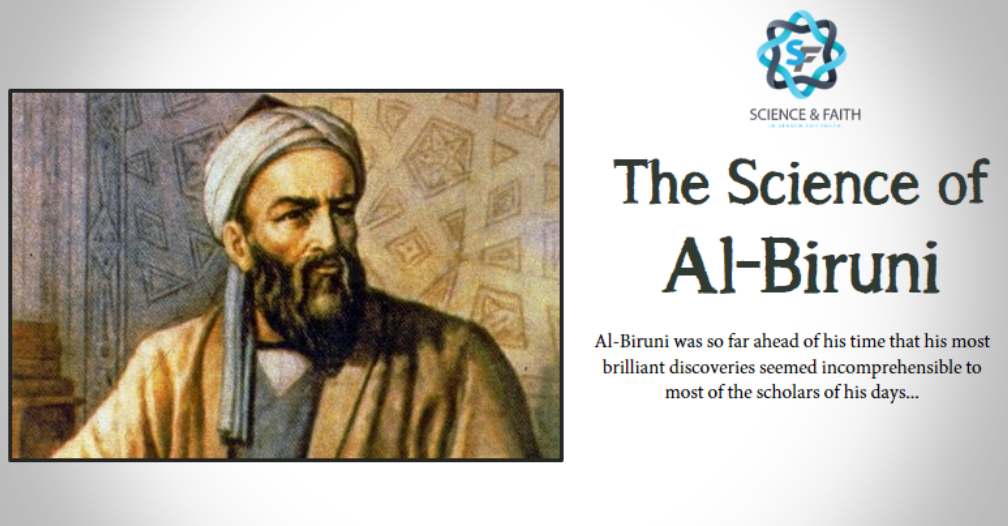 By Neenah Payne
By Neenah Payne
The great Persian scientist Abū al-Rayhān Muhammad ibn Ahmad al-Bīrūnī (973-1048) is considered the greatest of the Muslim polymaths. Born in Kath, Khwarezm in Western Central Asia – parts of which now belong to Uzbekistan, Kazakhstan, and Turkmenistan — Biruni moved Afghanistan.
“Al-Biruni is one the greatest scientists of all times,” Mohamed Said Abdi, a Nairobi-based high school teacher of Islamic Studies, told OnIslam.net. “He studied so many branches of science and did a lot of practical work on a number of scientific innovations. But in the study of history he wasn’t granted the kind of publicity he required, like those given to the Renaissance scientists in Europe,” says Fatuma Saman, a history teacher and a Principal at Nairobi Muslims Academy.
Al Biruni was a polymath during The Golden Age of Islam. His contributions span many disciplines including astronomy, physics, medicine, and cultural history. He has been called the “Founder of Indology”, “Father of Comparative Religion”, “Father of modern geodesy” and the first anthropologist. Al-Biruni also distinguished himself as an historian, chronologist, and linguist. In addition to Arabic, Biriuni was fluent in Turkish, Hebrew, Persian, Sanskrit, and Syriac.
Al Biruni’s works were highly regarded in his time and were widely read and studied for centuries. He is considered one of the most important scholars of the medieval Islamic world and his works have influenced the development of science and scholarship in many fields. Because of his extensive study of Indian heritage, some researchers consider him the “first anthropologist”. Comparative religion studies were Alberuni’s field of expertise. He had a keen interest in faiths such as Hinduism, Zoroastrianism, Christianity, Judaism, Buddhism, and Islam and thoroughly studied them.
The UNESCO Courier dedicated its 1974 issue to al-Biruni in 15 languages including Turkish. It introduced Al-Biruni as “The universal genius who lived a thousand years ago in Central Asia“. It pointed out that Al-Biruni inspired scientists such as Copernicus, Galileo, Newton, and Torricelli.
Al-Biruni: Greatest Persian Scientist
Al Biruni wrote several books on history, mineralogy, pharmacology, philology, and astronomy. Of the 146 books known to have been written by Bīrūnī, 95 were devoted to astronomy, mathematics, and related subjects like mathematical geography. Al Biruni also wrote a pharmacopoeia, the “Kitab al-saydala fi al-tibb” (Book on the Pharmacopoeia of Medicine) which lists synonyms for drug names in Syriac, Persian, Greek, Baluchi, Afghan, Kurdi, and some Indian languages.
Al Biruni used a hydrostatic balance to determine the density and purity of metals and precious stones. He classified gems by what he considered their primary physical properties such as specific gravity and hardness rather than the practice of the time of classifying them by color.
Al Biruni devised a novel method of determining the earth’s radius by means of the observation of the height of a mountain. He carried it out at Nandana in Pind Dadan Khan (present-day Pakistan). He used trigonometry to calculate the radius of the Earth using measurements of the height of a hill and measurement of the dip in the horizon from the top of that hill. His calculated radius for the Earth of miles was 2% higher than the actual mean radius of miles.
One of the most important of al-Biruni’s texts is Shadows which he is thought to have written around 1021. The contents include the Arabic nomenclature of shade and shadows, strange phenomena involving shadows, gnomonics, the history of the tangent and secant functions, applications of the shadow functions to the astrolabe and to other instruments, shadow observations for the solution of various astronomical problems, and the shadow-determined times of Muslim prayers.
Shadows is an extremely important source for the history of mathematics, astronomy, and physics. It also contains important ideas such as that acceleration is connected with non-uniform motion, using three rectangular coordinates to define a point in 3-space, and ideas that some see as anticipating the introduction of polar coordinates.
The mathematical contributions of al-Biruni include: theoretical and practical arithmetic, summation of series, combinatorial analysis, the rule of three, irrational numbers, ratio theory, algebraic definitions, method of solving algebraic equations, geometry, Archimedes’ theorems, trisection of the angle and other problems which cannot be solved with ruler and compass alone, conic sections, stereometry, stereographic projection, trigonometry, the sine theorem in the plane, and solving spherical triangles.
Greatest Polymath of the Islamic Golden Age
Amazon Description
Al-Biruni was an Islamic scholar who served on the courts of more than six caliphs. Like many of the great thinkers of the Islamic world’s Golden Age, his quest for truth motivated him to seek knowledge through research and innovation. He did this in the name of Allah. Al-Biruni set himself apart from his peers through his sheer range of expertise and drive for perfection. His considerable progress in astronomy, mathematics, geography, comparative religion, physical sciences, and history earned the respect of his colleagues, influenced countless academic followers, and remains as an inspiration to all who study his work today.
Al-biruni: Master Astronomer And Influential Muslim Scholar of Eleventh-century Persia
Golden Age of Islam: Who is Al-Biruni? 9/8/20
Abu Rayhan al-Biruni was an Iranian scholar and polymath during the Islamic Golden Age. He has been variously called as the “founder of Indology”, “Father of Comparative Religion”, “Father of modern geodesy”, and the first anthropologist.
The Science of al-Biruni says:
“In his early youth, fortune brought al-Biruni in contact with an educated Greek who was his first teacher. His foster father, Mansur, was a member of the royal family and a distinguished mathematician and astronomer. He introduced al-Biruni to Euclidean Geometry and Ptolemaic astronomy. Then, al-Biruni spent his first twenty-five years in Khwarezm where he studied the body of Islamic law, theology, grammar, mathematics, astronomy and other sciences. In the time, Khwarezm had long been famed for its advance culture. Its cities had magnificent palaces and religious colleges, and the sciences were esteemed and highly developed
Leaving his homeland, al-Biruni wandered, unsettled, for a brief period of time. He was interested in continuing his studies in astronomy, but this would be possible only in a large city. Then, al Biruni settled on Ravy, which was located near the present day Teheran. Unfortunately, in 996, al-Biruni was not yet well known outside of Kath and then he was unable to find a patron in Ravy; he was poor but remained confident and continued to study.
It happened that al-Khujandi (940- 1000), a respected astronomer, recorded in 994 the transit of the Sun near the solstices, measuring the latitude of Ravy. Al-Biruni found al-Khujandi’s results inaccurate. In his “The Determination of the Coordinate of Locations and for Correctly Ascertaining the Distances between Places”, al Biruni explained that the problem was in the sextant used for measurements. Because of this observation, he began to be accepted by other scholars and scientists. In 998, al-Biruni went to the court of the Amir of Tabaristan. There he wrote an important work, known as the “Chronology of Ancient Nations”.
Al-Biruni explained that the aim of his work was to establish, as accurately as possible, the time span of various eras. The book is also discussing various calendar systems such as the Arabian, Greek and Persian and several others. When Mahmud of Ghazni conquered the emirate of Bukhara (1017), he took all the scholars to his capital Ghazni. Al-Biruni spent then his life serving Mahmud and later his son Mas’ud. He was the court astronomer and accompanied Mahmud during the invasion of the north-west of India, living there for a few years.
During this time, he wrote the “History of India”, ending it around 1030. Let us note that most of the works of Al-Biruni are in Arabic although he wrote one of his masterpieces, the Kitab al-Tafhim, both in Persian and Arabic. Al-Biruni catalogued both his own works and those of al-Razi. In 1035-36, or a little thereafter, al Biruni wrote, at the urging of a friend, an “Epistle Concerning a List of the Books of Mohammad ibn Zakarīyā’ al-Rāzī”. This epistle consists of two parts, the first devoted to al-Razi and his works, the second to al-Biruni himself with an inventory. This sort of bibliographical treatment is modelled on those produced by Galen in antiquity.
Al-Biruni’s catalogue of his own literary production lists 103 titles divided into 12 categories: astronomy, mathematical geography, mathematics, astrological aspects and transits, astronomical instruments, chronology, comets, an untitled category, astrology, anecdotes, religion, and books of which he no longer possesses copies. His extant works include the “Indica, a Compendium of Indian Religion and Philosophy”, the “Book of Instruction in the Elements of the Art of Astrology”, and the abovementioned “Chronology of Ancient Nations”.
We find also “The Mas’udi Canon”, an encyclopaedic work on astronomy, geography and engineering, dedicated to Mas’ud, son of Mahmud of Ghazni, “Understanding Astrology”, which is a book containing questions and answers about mathematics and astronomy, the “Pharmacy”, about drugs and medicines, “Gems” a book on geology, minerals and gems, dedicated to the son of Mas’ud, the “Astrolabe”, the “History of Mahmud of Ghazni and his Father” and the “History of Khwarezmi.”
Founder of Modern Trigonometry
Al-Biruni was among those who laid the foundation for modern Trigonometry. He was a philosopher, geographer, astronomer, physicist, and mathematician. Six hundred years before Galileo, Al-Biruni discussed the theory of the earth rotating about its own axis. Al-Biruni carried out geodesic measurements and determined the earth’s circumference most ingeniously.
With the aid of mathematics, he enabled the Qibla direction to be determined from anywhere in the world. In the trigonometry domain, the theory of the functions; sine, cosine, and tangent were developed by Muslim scholars of the 10th century. Muslim scholars worked diligently in the development of plane and spherical trigonometry. The trigonometry of Muslims is based on Ptolemy’s theorem but is superior in two important respects: it employs the sine where Ptolemy used the chord and is in algebraic instead of geometric form.
What is Taught: The Greeks were the developers of trigonometry.
What Should Be Taught: Trigonometry remained largely a theoretical science among the Greeks.
It was developed to a level of modern perfection by Muslim scholars, although the credit must be given to al-Battani. The words describing this science’s basic functions, sine, cosine, and tangent, are all derived from Arabic terms. Thus, original contributions by the Greeks in trigonometry were minimal.
What is Taught: During the 17th century, Rene Descartes discovered that Algebra could be used to solve geometrical problems. By this, he greatly advanced the science of Geometry.
What Should be Taught: Mathematicians of the Islamic Empire accomplished precisely this as early as the 9th century A.D. Thabit bin Qurrah was the first to do so. He was followed by Abu’l Wafa, whose 10th-century book utilized Algebra to advance Geometry into an exact and simplified science.
The renaissance of astronomy in Baghdad in the 9th and 10th centuries. Al-Bīrūnī — Different phases of the moon- al-Biruni.
Biruni Ep 1: The Other Side of The River – Uzbekistan, The Cradle of Civilization 1 1/11/21
Biruni: A Scholar of Civilization documentary depicts the life of Al-Biruni, one of the most celebrated scientists in Islamic History. The documentary is divided into 3 episodes. Abu Rayhan al-Biruni (973 – after 1050) was a Muslim scholar and polymath during the Islamic Golden Age. He was probably the most learned person of the Middle Ages. He spoke Turkish, Persian, Sanskrit, Hebrew, Syriac and Arabic.
After 1017, he travelled to India to study the Indian civilization and then lived in Ghazna in Afghanistan for the rest of his life. He has been called variously the “founder of Indology”, “Father of Comparative Religion”, “Father of modern geodesy”, and the first anthropologist.
Al-Biruni was well versed in physics, mathematics, astronomy, and natural sciences, and distinguished himself as a historian, chronologist, and linguist. He studied almost all the sciences of his day and was rewarded abundantly for his tireless research in many fields of knowledge.
Royalty and other powerful elements in society funded Al-Biruni’s research and sought him out with specific projects in mind. Influential in his own right, Al-Biruni was himself influenced by the scholars of other nations, such as the Greeks from whom he took inspiration when he turned to the study of philosophy. He was, for his time, an admirably impartial writer on the customs and creeds of various nations, his scholarly objectivity earning him the title al-Ustadh (“The Master”) in recognition of his remarkable description of early 11th-century India.
Calculating the Earth’s Circumference by Al Biruni in Middle Ages 10/15/19
Abū Rayḥān Al-Bīrūnī (913-1050 AD) is a Muslim scientist who figured out a truly remarkable and ingenious method for calculating the Earth’s radius (and subsequently its circumference) with less than 1% (321 Km) margin of error. This method was very simple yet accurate, requiring just four measurements in all to be taken and then applying a trigonometric equation to arrive at the solution. What Biruni figured out with unprecedented accuracy and precision in the 10th century was not known to the west until the 16th century.
Abū al-Rayhān Muhammad ibn Ahmad al-Bīrūnī ( September 973 – December 1048), known as Al-Biruni in English, was a Persian Muslim scholar and polymath from the Khwarezm region. Al-Biruni is regarded as one of the greatest scholars of the medieval Islamic era and was well versed in physics, mathematics, astronomy, and natural sciences, and also distinguished himself as a historian, chronologist, and linguist. He was conversant in Khwarezmian, Persian, Arabic, Sanskrit, and also knew Greek, Hebrew, and Syriac.
The Science of al-Biruni says:
“George Sarton, the founder of the History of Science discipline, defined al-Biruni as “one of the very greatest scientists of Islam, and, all considered, one of the greatest of all times”. A universal genius that lived in the Central Asia a thousand of years ago, al-Biruni “was so far ahead of his time that his most brilliant discoveries seemed incomprehensible to most of the scholars of his days”, so wrote Bobojan Gafurov in his article on the Unesco Courier.”
Αl-Biruni was an astronomer, mathematician and philosopher, studying physics and natural sciences too. He was the first able to obtain a simple formula for measuring the Earth’s radius. Moreover, he thought possible the Earth to revolve around the Sun and developed the idea the geological eras succeed one another. In fact, in his scientific body of work he addresses almost all the sciences.
He had excellent knowledge of ancient Greek and studied several works by ancient Greek scientists in their original forms; among them there were the Aristotle’s Physics, Metaphysics, De Caelo, and Meteorology, the works of Euclid and Archimedes, the Almagest of the mathematician and astronomer Ptolemy. “When religious fanaticism swept medieval Europe… al-Biruni, as a forerunner of the Renaissance, was far in advance of the scientific thought then obtaining in Europe”.
Historians believe that the role Al-Biruni played in scientific discoveries is by far one of remarkable achievement among scientists of all times. He was the most successful scientist in the Middle Ages according to many scientists. He became legendary for his intellect and ingenuity in producing revolutionary science, leaving an indelible mark in the studies of many disciplines.
Celebrating Al-Biruni: A Muslim Genius and Polymath
Al-Biruni is said to be the first to carry out elaborate experiments linked to astronomical occurrence. He described the solar eclipse on April 8, 1019 and the lunar eclipse on September 17, 1019. In 1031, Al-Biruni concluded an all-embracing astronomical encyclopedia called Kitab al-Qanun al-Mas’udi (Latinized as “Canon Mas’udicus,”) in which he recorded his astronomical results and invented astronomical tables with logical conclusions.
According to the website MacTutor History of Mathematics Archive, maintained by Professor John J. O’Connor and Edmund F. Robertson at the University of St Andrews, Scotland, Al-Biruni determined the latitude of his hometown using the maximum altitude of the Sun at the tender age of 17.
“Important contributions to geodesy and geography were also made by Al-Biruni. He introduced techniques to measure the Earth and distances on it using triangulation. He found the radius of the Earth to be 6,339.6 km, a value not obtained in the West until the 16th century,” explains the website.
The Muslim scientist also racked his brain to expose and study gemstones and metals. Mineralogy was one among his best findings and here he put his best foot forward to precisely measure mineral densities. He is said to have described about 100 minerals, their varieties and rock occurrences, as well as characteristics such as color, hardness, production, and cost.
“This important reference on precious stones was quoted by many later scientists. It is the third authentic text known on mineralogy and equal precision in density measurement was not achieved in Europe until the 18th century,” wrote James Sandusky Aber, a Professor of Geology, in his work on History of Geology.
Biruni is most commonly known through his close association with Mahmood Ghaznavi, a famous Muslim king who ruled India and his son Sultan Masood. Impressed by Biruni’s scholarship and fame, Sultan Mahmood Ghaznavi took Biruni with him to India several times. Biruni traveled to many places in India over 20 years and studied Hindu philosophy, mathematics, geography, and religion. In return, he taught them Greek and Muslim sciences and philosophy.
He never exploited his work to achieve fame, authority, or material gains. When Sultan Masood sent him three camel-loads of silver coins in appreciation of his encyclopedic work “Al-Qanoon al-Masoodi,” (The Mas’udi Canon), Al-Biruni politely returned the royal gift saying, “I serve knowledge for the sake of knowledge and not for money.”
Elsewhere in anthropology, he studied the Indian community of his century, thus becoming the father of ‘Indology’ . His remarkable achievements studying the history, philosophy, medicine of India earned him the title “the first anthropologist.” According to many historians, the world’s enthusiastic clinch of modern anthropology could not have come easily without the pioneering footprint of Al-Biruni.
Al-Biruni and Mahmud of Ghazni
Abu-Rayhan-Al-Biruni (born 987 AD) was a Muslim scientist and historian attached to the court of Mahmud of Ghazni, the ravager of India. Al-Biruni traveled to India and there studied Sanskrit and translated texts into Arabic and Persian. He studied the history of India and was especially interested in the Indian systems of astronomy and astrology. The most famous of his many books, Kitab-Al-Hind, has been translated by Sachua as Al-Biruni’s India. This book shows the Muslim scholar’s view point of India. It is not exactly un-partisan.
Aside from that, Al-Biruni was a highly learned man for his time and supported himself by his knowledge of astrology for which he was highly esteemed. Many great Muslim princes and pretenders to the Caliphate sought his advice….
One day, Sultan Mahmud of Ghazni, while seated in his four-domed summer house in the garden of a thousand trees, requested Al-Biruni to forecast, by his knowledge of the stars, which door the Sultan would leave the building. When Al-Biruni had complied with this command and had written his answers secretly on a piece of paper which he placed under a quilt, the Sultan caused a hole to be made in the eastern wall and through this, he left the summer house. Then he called for Al-Biruni’s prognostication and found to his disgust that it was written, “the king will go out by none of these four doors, but an opening will be made in the eastern wall through which he will leave the building.”
Sultan Mahmud, who had hoped to turn the laugh against Al-Biruni, was so angry that he ordered him to be cast down from the roof. Al-Biruni’s fall was, however, broken by a mosquito curtain; and on being brought again before the Sultan and asked whether he had foreseen this, he produced from his pocket a notebook in which it was written, under that date: “Today, I shall be cast down from a high place, but reach the earth safely, and arise in a sound body.” Thereupon, the Sultan was even more upset and caused him to be confined to the citadel for six months.
The India is a massive work covering many aspects of the country. Al-Biruni describes the religion and philosophy of India, its caste system, and marriage customs. He studies the Indian systems of writing and numbers and examines the geography, Indian astronomy, astrology, and calendar.
Al-Biruni studied Indian literature in the original, translating several Sanskrit texts into Arabic. He also wrote several treatises devoted to certain aspects of Indian astronomy and mathematics. Al-Biruni was well read, having knowledge of Sanskrit literature on topics such as astrology, astronomy, chronology, geography, grammar, mathematics, medicine, philosophy, religion, and weights and measures.’
India By Al Biruni Editted by Qeyamuddin Ahmad
Book Description
Al-Biruni, celebrated mathematician and astronomer, came to India in the wake of the invading forces of Mahmud of Ghazni in the eleventh century (11 AD). He stayed in India from 1017- 1030 to study deeper Indian sciences and philosophies.
His enquiry into India, popularly known in its original Arabic version as Tarikhu’l Hind, is erudite and, as a historic chronicle of its kind, a classic. There is much in this chronicle that reads like fiction, while being at the same time an objective record of the history, character, manners, and customs of India of that time. Al-Biruni’s Kitabul Hind (Al- Biruni India), is a historical book that is of great importance in Indian cultural studies and is popular among world historians, especially in the Arab world
Sachau’s well-known English translation of the classic has been used in this publication, but edited specially by Q Ahmad for a large and popular readership.
Who was Al Biruni? 3/3/23
Who was Al Biruni? And why did he come to India with Mahmud of Ghazni? This article explores some of the fascinating facts about Al Biruni and his contributions; from his thorough observations of Indian sciences and culture made by him to the motivations that drove him to settle on the Indian mainland. You will get to learn some key facts about Al Biruni’s works and his life in the Indian subcontinent. They will help you understand the fascinating life of this Arab traveler and his geniuses. In this article, we will also discuss why Al Biruni (also called Alberuni) visited India, what he did, and how well-learned he was.
- Al Biruni’s trip to India inspired him to learn more about India’s Brahmanical legacy. He was in his 44th year when he first visited the nation and became the first Muslim intellectual to do so.
- He was captivated by Indian culture.
- During his time in India, he became well-versed in many aspects of Indian culture and Hindu life. He studied Indian philosophy, Sanskrit, and the country’s socioeconomic status.
- He was a Shia Muslim who had a rational mindset. His lyrical compositions try to unite Greek and Islamic ideas.
- His book Tahqiq-i-Hind describes India’s condition in societal, geopolitical, religious, and financial aspects.
- In his argument, he references key passages from the Bhagavad-Gita, the Upanishads, Patanjali, the Vedas-Puranas, and scientific literature written by the likes of Aryabhata, Nagarjuna, and others. He also relied heavily on tales from Indian mythology.
- He admired Indian philosophy without limitation.
- The Bhagavad-Gita and the Upanishads had a big impact on him.
- At times, along with Sufi teachings, he discovered parallels between Indian philosophy and Greek philosophy. Pythagoras, Galen, Plato, Socrates, Aristotle, etc. were some of the Greek Philosophers he studied about.
- He wrote a book as a survey of Indian life between the period 1017 AD to 1030 AD. The analysis, investigation, and findings by Al Biruni in India served as the foundation for this book.
- His journey to India began with observing Hindus and the civilization of the land, following a thorough absorption of Brahmanical literature and culture. Alberuni went into great detail about India, the country, its people, religion, philosophy, science, literature, and other forms of art.
Neenah Payne writes for Activist Post
Top image: Science of Faith
Become a Patron!
Or support us at SubscribeStar
Donate cryptocurrency HERE
Subscribe to Activist Post for truth, peace, and freedom news. Follow us on SoMee, Telegram, HIVE, Minds, MeWe, Twitter – X, Gab, and What Really Happened.
Provide, Protect and Profit from what’s coming! Get a free issue of Counter Markets today.

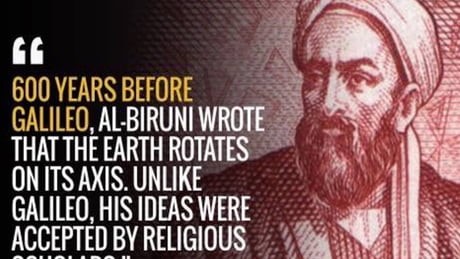


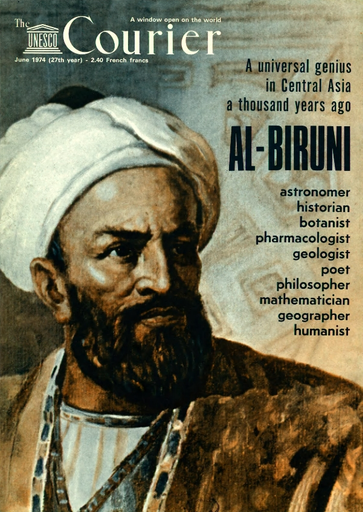
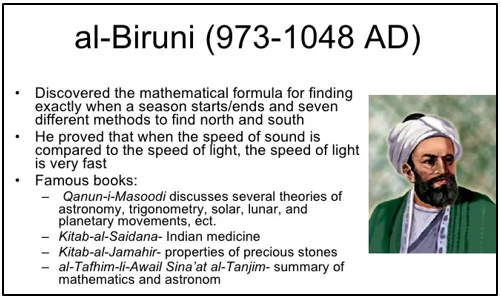
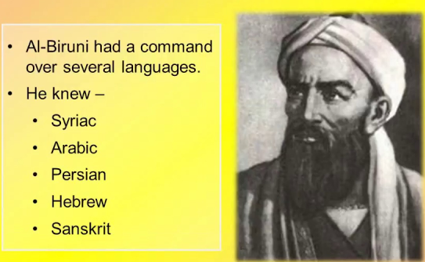
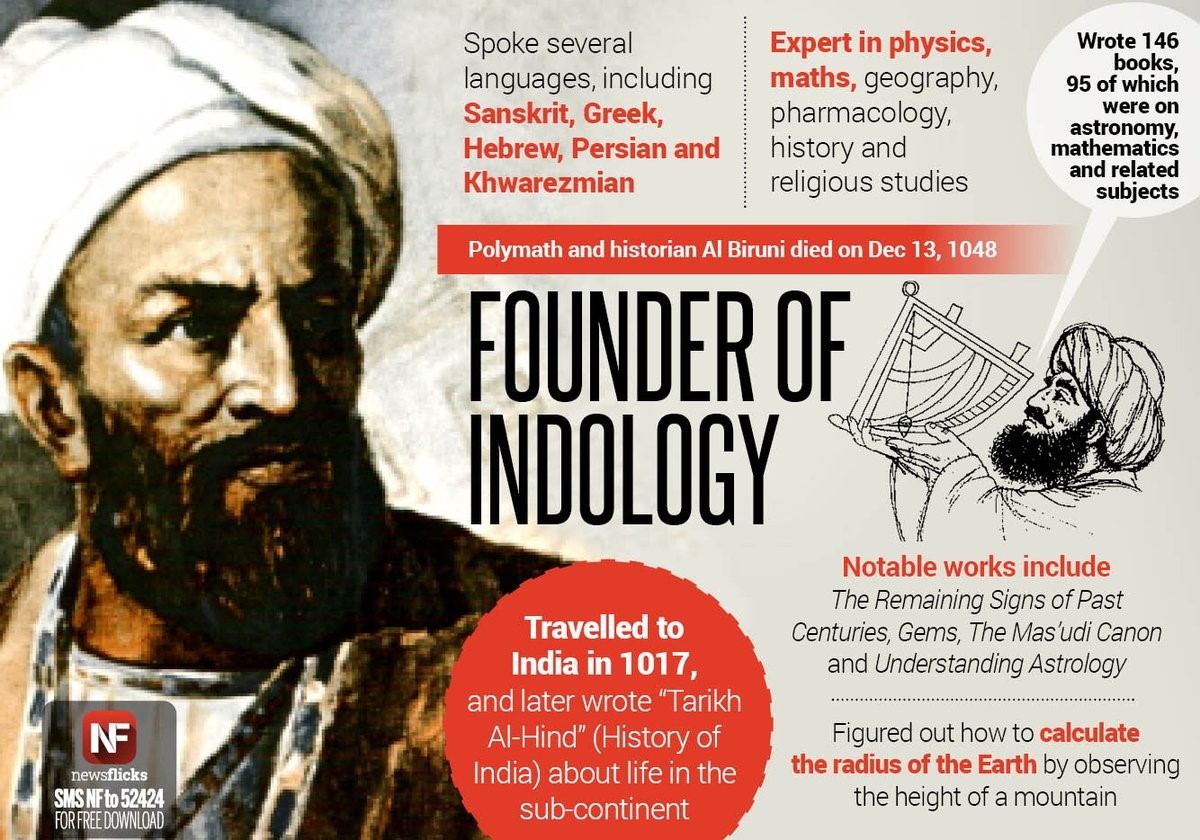
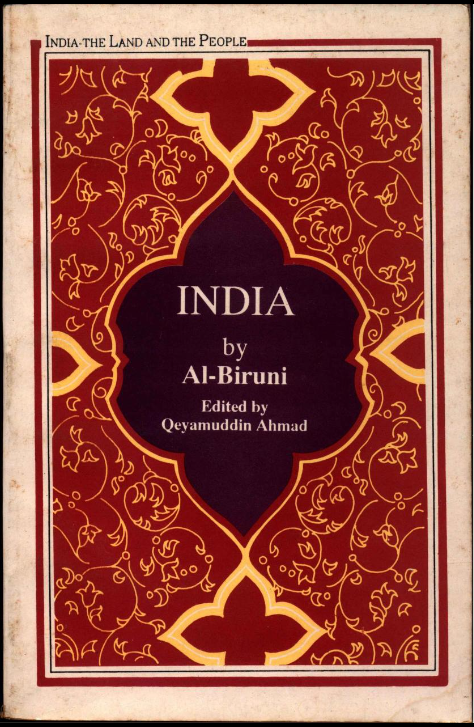
Be the first to comment on "Al-Biruni: Greatest Muslim Polymath"